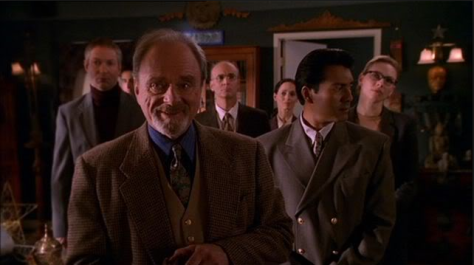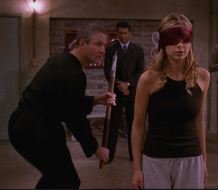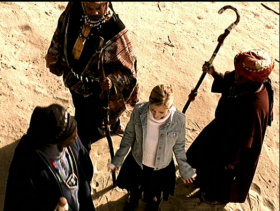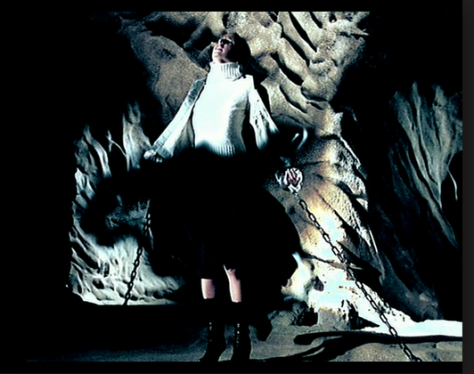As discussed in a previous post, within the world of Buffy the Vampire Slayer there is a matrilineal community (Owen 24) in the Slayer line, and this creates an emphasis on the powerful women that share the Slayer lineage. However in this post, I will be dissecting how this matriarchy, with a particular emphasis on Buffy’s term as Slayer, is challenged by the patriarchal systems and dominating male figures that exist within this narrative. A patriarchy can be defined as “…government or rule by a man or men.” (OED: Patriarchy). This element of rule or governing by men can be seen throughout the series by the Watcher’s Council, and later with the Shadow Men, but I will discuss how, while these systems attempt to control the actions of the Slayer, Buffy resists this, and to what effect.
As discussed by Franiuk and Scherr, there is often overriding themes of patriarchy in Vampire fiction in popular culture and literature, with the patriarchal relationships usually arising from the relationship between the male vampire and the female victim (Franiuk and Scherr 14). However, I argue that with the intentional role reversal of the girl as the Slayer in Buffy (Middleton 161), there is less of a patriarchal relationship between Buffy and her Vampire nemeses or her love interests Angel and Spike, and more of a patriarchal relationship between the institutions through which the Slayer lineage is organized and trained. The institution that becomes of great interest in the study of patriarchal systems in Buffy is the Watcher’s Council. The Watcher’s Council is an organization that has been developed to provide the Slayer with a Watcher; typically, a Slayer’s Watcher is a man who acts as a guardian to train her and prepare her to fight the Vampires and Demons she encounters on her patrols (Jowett 19). However, despite this seemingly symbiotic relationship, there is an element of oppression that exists in the relationship between Buffy and the Watcher’s Council, and thus, it becomes a patriarchal system that attempts to control her.

The primarily male Watcher’s Council, with the few female members included being masculinized through masculine dress.
The Watcher’s Council is a primarily male organization, thus becoming a binary to the exclusively female Slayer line. This creates an opposition in power structures. While the Slayer line is dictated by the power of women, The Watcher’s Council can be considered a “…male dominated hierarchy.” (Williams qtd. In Jowett 26). The Watcher’s Council largely controls Buffy’s actions through Giles, her Watcher in the majority of the series; through his job as Watcher, and member of the Council, Giles “…controls Buffy’s access to knowledge and parcels out information on a ‘need-to-know’ basis’.” (Williams qtd. in Jowett 128). Often, however, this power structure is not controlled by Giles directly, but by the Council dictating Giles’ treatment of Buffy. This hierarchical dynamic has led to Giles withholding information from Buffy on several occasions, such as in Season Three, in the episode “Helpless” in which Giles has been instructed to hypnotize Buffy and give her injections that neutralize her Slayer power right before her eighteenth birthday. Following this, she is to fight a vicious vampire in her weakened state as a rite of passage (“Helpless”).
While she is victorious, Buffy feels betrayed, and therefore she rejects the patriarchy of the Watcher’s Council. In deciding to take away her powers without her consent or even knowledge, the Council has stripped Buffy of any independence; they take away her ability to be autonomous in her Slayer duties, and consequently have worked to govern and control her actions and abilities. Following the encounter with the Vampire, Buffy rejects the authority of the superior member of the Watcher’s Council member Quentin Travers. As he congratulates her on a job well done, Buffy declares “Bite Me.” (“Helpless”). As a Vampire Slayer, this declaration involving the action of biting can be considered a direct reference to Buffy seeing the Watcher’s Council as rivaling Vampires with their actions of manipulation and danger towards her. She challenges the Council’s authority and motive by doing this, and thus, she rejects the control of the patriarchal system in which the council has placed her in (Labre and Duke 142). This rejection culminates further in the season, when Buffy goes to the Council for help in curing Angel who has been poisoned. Wesley, Buffy’s Watcher at the time, says the Council has rules against this, and their orders are clear. To this, Buffy responds “…Orders? I don’t think I’m going to be taking anymore orders. Not from you, not from them [the Council]…I’m not working for them anymore.” (“Graduation Day: Part 1”). In this declaration, Buffy realizes that she lacks agency under the Council’s rule, and as such, she overtly dismisses them (Jowett 24).

The Watcher’s Council testing to see if Buffy’s strength and fighting abilities are adequate in their review.
Despite this declaration of independence and autonomy in her role as the Slayer, Buffy is required to go to the Council regarding information they have on Glory, the Big Bad of Season Five. Before they will give her this information, however, Buffy and the Scoobies are forced to go through a review process that tests their skills, motives and abilities (“Checkpoint”). This process acts as a form of control this patriarchal system is trying to exert over Buffy and her friends; they are restricting Buffy’s abilities once again, in that she becomes limited in what she can do without their information. She thus falls under their control, albeit, under threats of sending Giles, the one aspect of the patriarchal Council that Buffy has allowed to remain in her life consistently, back to England. However, after encountering a foe prior to her review, Buffy comes to a realization. When she approaches the council, she asserts: “There isn’t going to be a review…no review, no interrogation, no questions you know I can’t answer…See, I’ve had a lot of people talking at me the last few days. Everyone just lining up to tell me how unimportant I am. And I finally figured out why: Power. I have it. They don’t. This bothers them…” (“Checkpoint”).
In this instance, Buffy is asserting her dominance over the Council. She is actively asserting that her power, her abilities makes her the superior authority in this situation. While she has slightly devolved from the autonomy she achieved by quitting the Council in Season Three by returning to them for help, Buffy has worked to reassert her authority in her return. Indeed, by refusing the controls that the patriarchal Watcher’s Council tried to set on her, Buffy has effectively rejected patriarchal authority, and replaced it with her own. She becomes the dominant figure, as she dictates how the relationship between she and the Council will operate from then on, and in doing so, Buffy successfully overthrows the patriarchy of the Council.

Buffy, surrounded by the Shadow Men as they attempt to coerce her into submission.
Perhaps and even more aggressive patriarchal dynamic occurs in Season Seven, when Buffy learns about the creation of the First Slayer. Upon finding a Shadow Caster from pre-civilization, Dawn reads the origin story of the First Slayer: “First there is the earth…Then there came the Demons. After Demons, there came men. Men found a girl. The men took the girl to fight the Demon…all Demons. They…chained her to the earth…” (“Get it Done”). Following this, a dimensional portal opens. Buffy finds herself face to face with three men called the Shadow Men. As seen here, these men circle Buffy explaining “We have been here since the beginning. Now, we are almost at the end. You are the Hellmouth’s last guardian.” (“Get it Done”). One of the Shadow Men hits Buffy with his staff, knocking her unconscious. Upon waking, the Shadow Men explain that they are back to the origins of the Slayer; indeed, Buffy is facing a similar situation as the First Slayer, as she is chained to the ground and at their mercy. What this achieves is an overtly oppressive system; these men have forced her into submission, and through this have gained the upper hand. Buffy is trapped by these chains, and thus, she becomes less able to fight back.
The Shadow Men explain that they created the First Slayer through a type of assault. These men forced the essence of a Demon – the heart, spirit and energy – into the girl who would become the First Slayer and used her to fight their battles with Demons (“Get it Done”). This acts as a metaphorical rape of the First Slayer; by trapping this girl, and forcing the essence of a Demon on her, they have violated this girl (Jowett 26). The actions of these men demonstrate a patriarchal dominance, in that they have wielded their mystic male powers over this girl, and have done so without her consent. The Shadow Men become figures of complete male dominance through this metaphorical rape of the First Slayer, and attempt to perform the same dominating ritual on Buffy; chained to the ground as the First Slayer was, they attempt to force this Demonic essence into her. As seen in the photo from this scene, Buffy, still chained and in a spotlight that emphasizes her vulnerability in this situation by illuminating both the chains holding her and her struggle to get free, is engulfed by this blackened force. It seems to enter her and surround her body, and she begs the men to “…make it stop.” (“Get it Done”). They do not, instead insisting that this will make her powerful.

Buffy, chained to the Earth by the Shadow Men, is shown as vulnerable and being engulfed by their penetrative force
This is where Buffy rejects the patriarchy and oppression she is facing in this situation; she questions the authority of the men, stating that they are “…just men. Just the men who did this to her, whoever that girl was before she was the First Slayer…You violated that girl. Made her kill for you because you are weak and pathetic…” (“Get it Done”). While Buffy is saying this, she rips her chains from the ground and begins to dominate the Shadow Men in a physical fight. She is victorious, eventually breaking the mystical staff that summoned the Demonic essence and causing it to dissipate. What Buffy has done here is re-appropriate her power. These men have attempted to exert patriarchal dominance over her, but she resists them, questioning their authority and power. By resisting their attempts to instil the Demonic essence in her, Buffy rejects their dominance over her, thus asserting her female power as superior to theirs. She has rejected the patriarchy, and in doing so, has asserted her authority as a female.